Economy
Different Irrigation Systems
- 17 Feb 2020
- 10 min read
Irrigation
- Irrigation is the artificial application of water to the soil or agricultural field. It is the replacement or supplementation of rainwater with another source of water. It is used in dry areas and during periods of inadequate rainfall.
- The main idea behind irrigation systems is to assist in the growth of agricultural crops and plants by maintaining with the minimum amount of water required, suppressing weed growth in grain fields, preventing soil consolidation etc.
Well and Tube Well Irrigation
- Wells are mainly found in U.P., Bihar, Tamil Nadu, etc. There are various types of wells – shallow wells, deep wells, tube wells, artesian wells, etc. From the shallow wells water is not always available as the level of water goes down during the dry months. Deep wells are more suitable for the purpose of irrigation as water from them is available throughout the year.
- At places where ground water is available, a tube-well can be installed near the agricultural area. A deep tube well worked by electricity, can irrigate a much larger area (about 400 hectares) than a surface well (half hectares). Tube wells are mostly used in U.P., Haryana, Punjab, Bihar and Gujarat.
- Merits: Well is simplest, cheapest and independent source of irrigation and can be used as and when the necessity arises. Several chemicals such as nitrate, chloride, sulphate, etc. found in well water add to the fertility of soil. More reliable during periods of drought when surface water dries up.
- Demerits: Only limited area can be irrigated. In the event of a drought, the ground water level falls and enough water is not available. Tubewells can draw a lot of groundwater from its neighbouring areas and make the ground dry and unfit for agriculture.
Canal Irrigation
- Canals can be an effective source of irrigation in areas of low level relief, deep fertile soils, perennial source of water and extensive command area. Therefore, the main concentration of canal irrigation is in the northern plain of India, especially the areas comprising Uttar Pradesh, Haryana and Punjab.
- The digging of canals in rocky and uneven areas is difficult and uneconomic. Thus, canals are practically absent from the Peninsular plateau area. However, the coastal and the delta regions in South India do have some canals for irrigation.
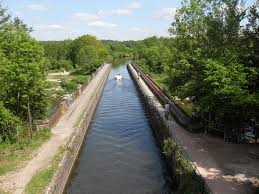
- Two types: Inundation canals, which are taken out from the rivers without any regulating system like weirs etc. at their head. Such canals provide irrigation mainly in the rainy season when the river is in flood and there is excess water. Perennial Canals are those which are taken off from perennial rivers by constructing a barrage across the river. Most of the canals in India are perennial.
- Merits: Most of the canals provide perennial irrigation and supply water as and when needed. This saves the crops from drought conditions and helps in increasing the farm production.
- Demerits: Many canals overflow during the rainy season and flood the surrounding areas. Canal irrigation is suitable in plain areas only.
Tank Irrigation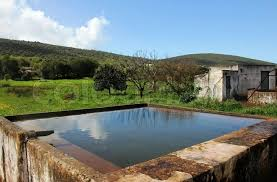
- A tank is developed by constructing a small bund of earth or stones built across a stream. The water impounded by the bund is used for irrigation and other purposes. Tank comprises an important source of irrigation in the Karnataka Plateau, MP, Maharashtra, Odisha, Kerala Bundelkhand area of UP, Rajasthan and Gujarat.
- Merits: Most of the tanks are natural and do not involve heavy cost for their construction and have longer life span. In many tanks, fishing is also carried on, which supplements both the food resources and income of the farmer.
- Demerits: Many tanks dry up during the dry season and fail to provide irrigation when it is required. Lifting of water from tanks and carrying it to the fields is a strenuous and costly exercise.
Drip Irrigation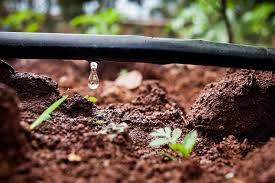
- In drip irrigation, water is applied near the plant root through emitters or drippers, on or below the soil surface, at a low rate varying from 2-20 liters per hour. The soil moisture is kept at an optimum level with frequent irrigations.
- Among all irrigation methods, drip irrigation is the most efficient and can be practiced for a large variety of crops, especially in vegetables, orchard crops, flowers and plantation crops.
- Merits: Fertilizer and nutrient loss is minimized due to localized application and reduced leaching. Field leveling is not necessary. Recycled non-potable water can be used. Water application efficiency increases. Soil erosion and weed growth is lessened.
- Demerits: Initial cost can be more, can result in clogging, wastage of water, time and harvest, if not installed properly.
Sprinkler Irrigation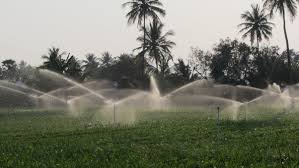
- In this method, water is sprayed into the air and allowed to fall on the ground surface somewhat resembling rainfall. The spray is developed by the flow of water under pressure through small orifices or nozzles. The sprinkler irrigation system is a very suitable method for irrigation on uneven lands and on shallow soils.
- Nearly all crops are suitable for sprinkler irrigation systems except crops like paddy, jute, etc. The dry crops, vegetables, flowering crops, orchards, plantation crops like tea, coffee are all suitable and can be irrigated through sprinklers.
- Merits: Suitable to all types of soil except heavy clay. Water saving. Increase in yield. Saves land as no bunds etc. are required.
- Demerits: Higher initial cost. Under high wind conditions and high temperature distribution and application efficiency is poor.
Other Types of Irrigation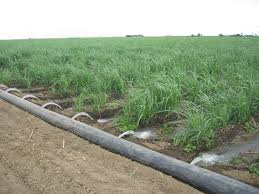
- Furrow Irrigation: Furrow irrigation is a type of surface irrigation in which trenches or “furrows” are dug between crop rows in a field. Farmers flow water down the furrows and it seeps vertically and horizontally to refill the soil reservoir. Flow to each furrow is individually controlled.
- One of the difficulties of furrow irrigation is ensuring uniform dispersion of water over a given field. Another difficulty with furrow irrigation is the increased potential for water loss due to runoff.
- Surge Irrigation: Surge irrigation is a variant of furrow irrigation where the water supply is pulsed on and off in planned time periods. The wetting and drying cycles reduce infiltration rates resulting in faster advance rates and higher uniformities than continuous flow.
- Ditch Irrigation: It is a rather traditional method, where ditches are dug out and seedlings are planted in rows. The plantings are watered by placing canals or furrows in between the rows of plants. Siphon tubes are used to move the water from the main ditch to the canals.
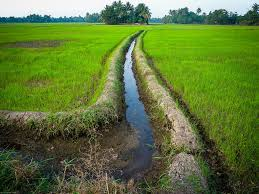
- Sub Irrigation or Seepage Irrigation: It is a method of irrigation where water is delivered to the plant root zone from below the soil surface and absorbed upwards. The excess may be collected for reuse.
- Advantages are water and nutrient conservation, and labor-saving.
- The outfitting cost is relatively high. Potential problems, such as the possibility of increased presence of disease in recycle water.
Way Forward
The farmers should be acquainted with the type of soil moisture, quality of irrigation water, frequency of irrigation for the proper implementation of irrigation systems.






